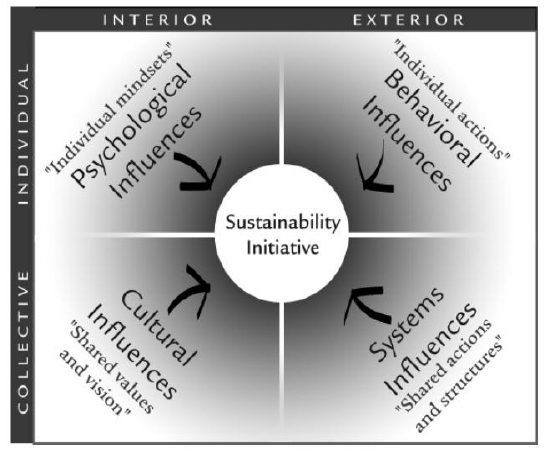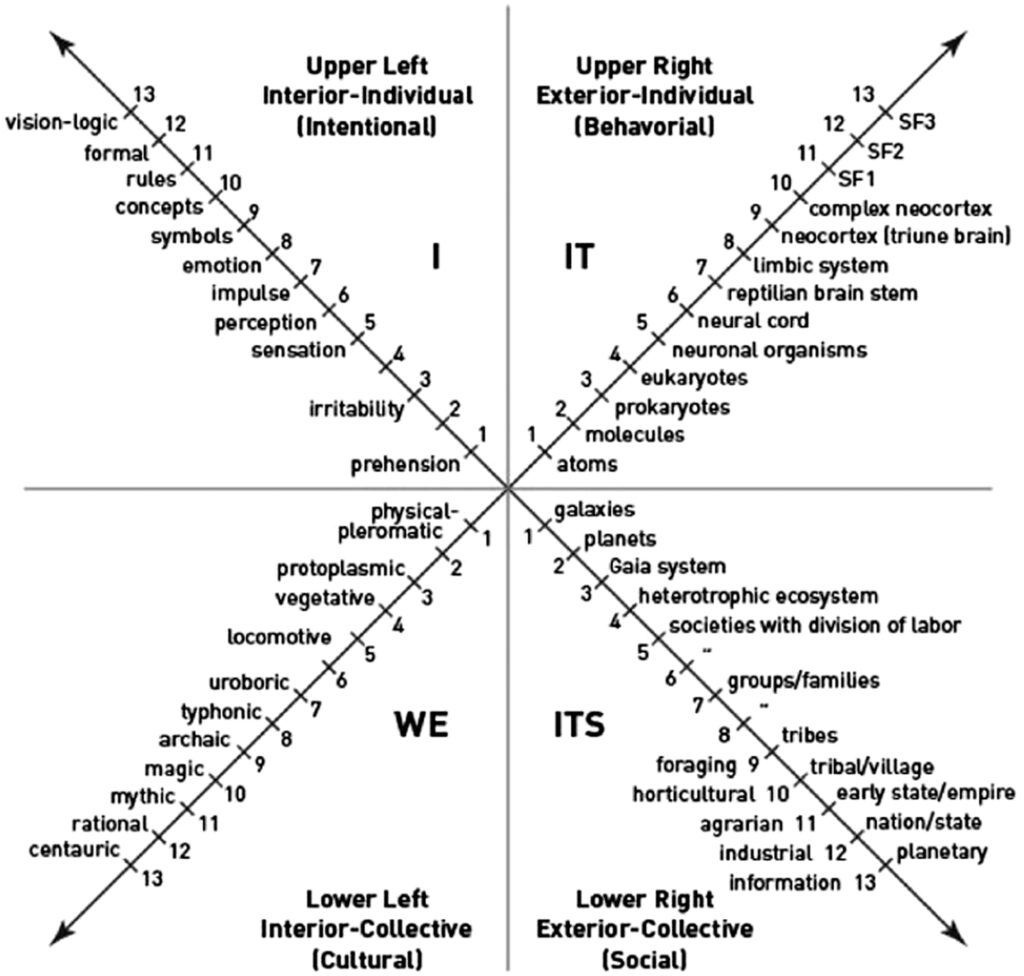Imagine having a map that can guide you through the complexities of your own mind. A tool that can help you understand the hidden patterns and dynamics that shape your thoughts, emotions, and behaviors.
The human experience is complex, multifaceted, and inherently paradoxical. How can we make sense of this complexity? One powerful tool is the quadrant model, developed by Ken Wilber. In this article, we’ll explore the quadrant model in depth, and how it can help us better understand human psychology and behavior.
The Four Quadrants Model
The Four Quadrants model is a framework for understanding human experience and consciousness. It divides human experience into four quadrants:
- Upper-Left (UL) Quadrant: Individual-Interior: Focuses on subjective experiences, thoughts, emotions, and intentions. This quadrant is concerned with personal growth, self-awareness, and emotional intelligence.
- Upper-Right (UR) Quadrant: Individual-Exterior: Examines observable behaviors and physiological processes. This quadrant is concerned with behavioral patterns, brain function, and physical health.
- Lower-Left (LL) Quadrant: Collective-Interior: Explores cultural narratives, shared values, and interpersonal relationships. This quadrant is concerned with social dynamics, cultural context, and collective consciousness.
- Lower-Right (LR) Quadrant: Collective-Exterior: Analyzes social systems, structures, and institutions. This quadrant is concerned with systemic influences, power dynamics, and social change.

The Upper-Left Quadrant: Subjective Experience
The Upper-Left quadrant is concerned with subjective experience, including thoughts, emotions, and intentions. Imagine a person with anxiety who is struggling to manage their emotions. By examining their subjective experience, they may realize that their anxiety is rooted in a deep-seated fear of failure. This insight can help them develop more effective coping strategies and work towards personal growth.
- Case Study: Sarah, a college student, struggled with anxiety and self-doubt. By examining her subjective experience, she realized that her anxiety was rooted in a fear of not meeting her parents’ expectations. With this insight, she was able to develop more effective coping strategies, such as mindfulness and self-compassion, and work towards personal growth. Through journaling and self-reflection, Sarah was able to identify patterns and triggers of her anxiety, and develop a more positive and compassionate relationship with herself.
- Phenomenology: The study of conscious experience or perception. Phenomenology can help individuals develop a greater understanding of their subjective experience and gain insight into their thoughts, emotions, and intentions.
- Intentionality: The ability to direct one’s attention and awareness towards specific objects or goals. Intentionality can help individuals develop greater focus and concentration, and achieve their goals.
The Upper-Right Quadrant: Objective Behavior
The Upper-Right quadrant focuses on observable behaviors and physiological processes. Imagine a person trying to improve their physical health by exercising regularly. By tracking their observable behaviors, such as their workout routine and diet, they can identify areas for improvement and develop a more effective plan.
- Case Study: John, a 40-year-old man, wanted to improve his physical health. By tracking his observable behaviors, he realized that he was not getting enough sleep and was consuming too much sugar. With this insight, he was able to develop a more effective plan for improving his physical health, including establishing a consistent sleep schedule and reducing his sugar intake. Through regular exercise and healthy eating, John was able to improve his physical health and reduce his risk of chronic disease.
- Behaviorism: The study of observable behaviors and the environmental factors that influence them. Behaviorism can help individuals understand the role of environment and reinforcement in shaping their behaviors.
- Neuroscience: The study of the structure and function of the brain and nervous system. Neuroscience can help individuals understand the physiological basis of their behaviors and develop more effective strategies for improving their physical and mental health.
The Lower-Left Quadrant: Cultural Narratives
The Lower-Left quadrant explores cultural narratives, shared values, and interpersonal relationships. Imagine a person from a collectivist culture who values family and community above individual needs. By understanding the cultural narratives and shared values of their community, they can better navigate social situations and build stronger relationships.
- Case Study: Maria, a woman from a collectivist culture, struggled to balance her individual needs with the expectations of her family and community. By understanding the cultural narratives and shared values of her community, she was able to develop more effective strategies for navigating social situations and building stronger relationships. Through open communication and empathy, Maria was able to build stronger relationships with her family and community, and find a sense of belonging and purpose.
- Cultural Studies: The study of cultural narratives, values, and practices. Cultural studies can help individuals understand the role of culture in shaping their experiences and behaviors.
- Social Constructivism: The theory that social reality is constructed through social interactions and agreements. Social constructivism can help individuals understand the role of social context in shaping their perceptions and behaviors.
The Lower-Right Quadrant: Social Systems
The Lower-Right quadrant analyzes social systems, structures, and institutions. Imagine a person navigating the healthcare system after a serious illness. By examining the social systems and institutions that shape healthcare, they can better understand the complexities of the system and advocate for themselves.
- Case Study: David, a patient with a chronic illness, struggled to navigate the healthcare system. By examining the social systems and institutions that shape healthcare, he was able to develop more effective strategies for advocating for himself and getting the care he needed. Through education and advocacy, David was able to navigate the healthcare system more effectively and improve his health outcomes.
- Systems Theory: The study of complex systems and their interactions. Systems theory can help individuals understand the interconnectedness of social systems and the ways in which they shape individual and collective behavior.
- Institutional Analysis: The study of social institutions and their impact on individual and collective behavior. Institutional analysis can help individuals understand the role of institutions in shaping their experiences and behaviors.
Applying the Quadrant Model in Daily Life
The quadrant model can be applied in various ways in daily life, including:
- Personal Growth: By understanding the interplay between subjective experience (UL) and observable behavior (UR), individuals can develop more effective strategies for personal growth and self-improvement.
- Relationships: By considering the cultural narratives (LL) and social systems (LR) that influence relationships, individuals can develop more empathy and understanding for others.
- Decision-Making: By analyzing the systemic influences (LR) and cultural narratives (LL) that shape decision-making, individuals can make more informed choices.
- Conflict Resolution: By understanding the interplay between individual intentions (UL) and social systems (LR), individuals can develop more effective strategies for conflict resolution.

As I reflect on the quadrant model, I’m reminded of the countless times it’s helped me navigate my own life’s complexities. From managing stress to building stronger relationships, this framework has been a constant source of guidance and growth.
By integrating the insights from all four quadrants, individuals can cultivate a deeper understanding of themselves and the world around them, leading to more effective strategies for navigating life’s complexities and achieving greater fulfillment.



